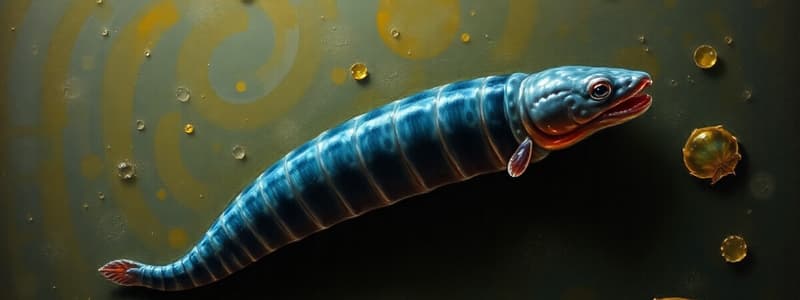Podcast
Questions and Answers
Which characteristic is NOT true for the phylum Platyhelminthes?
Which characteristic is NOT true for the phylum Platyhelminthes?
- They have a complex respiratory system (correct)
- They have flame cells in their excretory system
- They can be free living or parasitic
- All members are hermaphrodites
All organisms in the phylum Platyhelminthes have a respiratory system.
All organisms in the phylum Platyhelminthes have a respiratory system.
False (B)
What is the main function of flame cells in the excretory system of Platyhelminthes?
What is the main function of flame cells in the excretory system of Platyhelminthes?
To collect excess water and excretory wastes
Platyhelminthes are _____ symmetrical organisms.
Platyhelminthes are _____ symmetrical organisms.
Match the following characteristics with the correct description:
Match the following characteristics with the correct description:
What is one of the characteristics of the phylum Platyhelminthes?
What is one of the characteristics of the phylum Platyhelminthes?
All organisms within the phylum Platyhelminthes have a flattened body structure.
All organisms within the phylum Platyhelminthes have a flattened body structure.
What type of body structure do Platyhelminthes have?
What type of body structure do Platyhelminthes have?
The body wall of organisms in the phylum Platyhelminthes consists of three ______.
The body wall of organisms in the phylum Platyhelminthes consists of three ______.
Match the following characteristics to their descriptions related to Platyhelminthes:
Match the following characteristics to their descriptions related to Platyhelminthes:
What structure in the excretory system is responsible for collecting excess water and waste?
What structure in the excretory system is responsible for collecting excess water and waste?
The nervous system has a ladder-like arrangement with longitudinal nerves connected transversely.
The nervous system has a ladder-like arrangement with longitudinal nerves connected transversely.
What term describes organisms that have both male and female reproductive organs?
What term describes organisms that have both male and female reproductive organs?
The eyespots are located near the ________ ganglia.
The eyespots are located near the ________ ganglia.
Match the following systems or structures with their descriptions:
Match the following systems or structures with their descriptions:
What is the initial host that Miracidium invades?
What is the initial host that Miracidium invades?
Cercaria is a larva that is capable of swimming.
Cercaria is a larva that is capable of swimming.
What larval stage develops from Miracidium within the snail?
What larval stage develops from Miracidium within the snail?
The larva that develops from Miracidium is called _____ and is capable of swimming.
The larva that develops from Miracidium is called _____ and is capable of swimming.
Match the following stages of development with their characteristics:
Match the following stages of development with their characteristics:
What does the larva primarily do after contacting the parasite?
What does the larva primarily do after contacting the parasite?
The larva of the parasite spends several months eating the liver.
The larva of the parasite spends several months eating the liver.
How long does the larva usually browse and eat the liver?
How long does the larva usually browse and eat the liver?
Which class includes free-living worms found in salt water or fresh water?
Which class includes free-living worms found in salt water or fresh water?
The larva finds the liver and starts eating _____ cells.
The larva finds the liver and starts eating _____ cells.
Match the following stages of the larva's behavior with their descriptions:
Match the following stages of the larva's behavior with their descriptions:
All members of the Platyhelminthes phylum are parasitic.
All members of the Platyhelminthes phylum are parasitic.
What are the two environments where turbelleria class worms can be found?
What are the two environments where turbelleria class worms can be found?
The subkingdom of Platyhelminthes belongs to the larger classification system called __________.
The subkingdom of Platyhelminthes belongs to the larger classification system called __________.
Match the following classes with their characteristics:
Match the following classes with their characteristics:
Flashcards
Platyhelminthes Phylum
Platyhelminthes Phylum
A group of invertebrates characterized by a flattened body.
Acoelomate
Acoelomate
Animals without a body cavity.
Body wall layers
Body wall layers
Platyhelminthes have three layers in their body wall.
Flattened body
Flattened body
Signup and view all the flashcards
Organ System
Organ System
Signup and view all the flashcards
Platyhelminthes
Platyhelminthes
Signup and view all the flashcards
Bilateral symmetry
Bilateral symmetry
Signup and view all the flashcards
Flame cells
Flame cells
Signup and view all the flashcards
Excretory system
Excretory system
Signup and view all the flashcards
Respiration in Platyhelminthes
Respiration in Platyhelminthes
Signup and view all the flashcards
Turbellaria
Turbellaria
Signup and view all the flashcards
Trematoda
Trematoda
Signup and view all the flashcards
Cestoda
Cestoda
Signup and view all the flashcards
What distinguishes Turbellaria from Trematoda and Cestoda?
What distinguishes Turbellaria from Trematoda and Cestoda?
Signup and view all the flashcards
Excretory tubules
Excretory tubules
Signup and view all the flashcards
Excretory pores
Excretory pores
Signup and view all the flashcards
Cerebral ganglia
Cerebral ganglia
Signup and view all the flashcards
Ladder-like nervous system
Ladder-like nervous system
Signup and view all the flashcards
Miracidium
Miracidium
Signup and view all the flashcards
Lymnaea
Lymnaea
Signup and view all the flashcards
Cercaria
Cercaria
Signup and view all the flashcards
Definitive Host
Definitive Host
Signup and view all the flashcards
Intermediate Host
Intermediate Host
Signup and view all the flashcards
Liver Stage
Liver Stage
Signup and view all the flashcards
Larva's Feeding Habits
Larva's Feeding Habits
Signup and view all the flashcards
Days After Contact
Days After Contact
Signup and view all the flashcards
Initial Contact
Initial Contact
Signup and view all the flashcards
Parasite's Life Cycle
Parasite's Life Cycle
Signup and view all the flashcards
Study Notes
Platyhelminthes
- Phylum of acoelomate animals
- Body wall has three layers
- Flattened and bilaterally symmetrical
- Hermaphrodites (except Shistosoma)
- Free-living or parasitic
- Respiration by simple diffusion
- Lacking a respiratory system
Excretory System
- Flame cells (protonephridia)
- Collect excess water and wastes
- Connected to excretory tubules that exit to the outside
Nervous System
- Cephalized with a pair of cerebral ganglia at the anterior end
- Two longitudinal nerve cords connected transversely
- Ladder-like arrangement
Sense Organs
- Two cup-shaped eyespots near the cerebral ganglia
Sexual Reproduction
- Hermaphroditic (possess both male and female reproductive organs)
- Fertilization occurs simultaneously when two worms mate
- Eggs are laid in protective capsules
Asexual Reproduction (Regeneration)
- Fission occurs in some species, specifically Planaria
- Posterior part of the worm attaches to a surface
- Body constricts behind the pharynx
- Anterior part moves forward, splitting the worm into two
- Each half regenerates to become a complete Planaria
Class Turbellaria
- Free-living in fresh or saltwater
- Resemble a plant leaf, covered by cilia
- Possess suckers
- Planaria species live in fresh water, hiding beneath rocks and water plants
- Planaria possesses a dorsal surface that points upwards and a ventral surface directed downwards
Class Trematoda (Flukes)
- Leaf-like, unsegmented bodies
- Typically have two suckers (oral and ventral)
- Gastrovascular cavity bifurcates into two intestinal caecae
- All are parasitic, except for Shistosoma
- Hermaphrodites
Fasciola gigantica Life Cycle
- Female lays eggs in the liver of an infected human
- Immature eggs are discharged into biliary ducts and feces
- If eggs land in water, they develop into miracidia
- Miracidia infect a snail (e.g., Lymnaea)
- Develop into cercariae, which encyst on aquatic plants
- Humans or other animals ingest the encysted metacercariae
- Metacercariae develop into adults in the liver's bile ducts
Studying That Suits You
Use AI to generate personalized quizzes and flashcards to suit your learning preferences.




